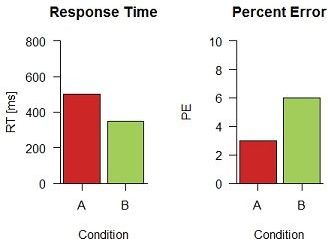Statistics and Modeling (Janczyk and Liesefeld)

Speed-Accuracy Tradeoffs (Janczyk and Liesefeld)
In many (cognitive) psychological investigations, reaction times and error measures are measured. Ideally, results obtained for both measures have the same direction. In practice, however, it happens that both measures point in different directions (see, for example, the figure on the right). This makes an interpretation difficult because, for example, it is unclear which of the two conditions A and B was now "more difficult".
To solve this problem, various measures have been proposed in the past to combine reaction times and errors, but the adequacy of such methods remains unclear. We have begun to systematically examine the behavior of various measures. After a first fundamental work on this topic, we are working on extension and refinement for more specific situations.
Publication:
Liesefeld, H.R., & Janczyk, M. (2023). Same same but different: Subtle but consequential differences between two measures to linearly integrate speed and accuracy (LISAS vs. BIS). Behavior Research Methods, 55, 1175-1192.
Liesefeld, H.R., & Janczyk, M. (2019). Combining speed and accuracy to control for speed-accuracy tradeoffs (?). Behavior Research Methods, 51, 40-60. (see also here)
Modeling
In various works we have used diffusion models to examine theories. We are currently developing an accumulator model to explain various phenomena that occur during multitasking. As part of the methodological development, we are working on a PDE solution for the case of time-dependent drift rates in the diffusion model. This work is done in cooperation with Prof. Dr. Thomas Richter (Magdeburg) and Prof. Dr. Rolf Urich (Tübingen).
Richter, T., Ulrich, R., & Janczyk, M. (2023). Diffusion models with time-dependent parameters: An analysis of computational effort and accuracy of different numerical methods.Journal of Mathematical Psychology, 114, 102756.
